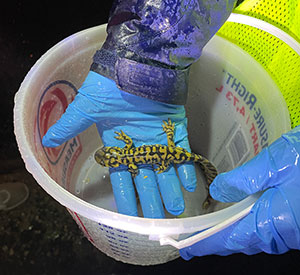
Contact Us
Institutional Communications
Bureau of Mines Building, Room 137
Laramie, WY 82071
Phone: (307) 766-2929
Email: cbaldwin@uwyo.edu
UW Biodiversity Institute to Host Salamander Migration Initiative During April
Published April 04, 2023

UW’s Biodiversity Institute will host the Laramie Salamander Migration Initiative,
which includes a Salamander Saturday event April 15; identifying salamanders; and
having the public help with salamander migration nights during the spring. This Western
tiger salamander was found during last year’s migration night. (Mindy Meade Photo)
The University of Wyoming’s Biodiversity Institute once again will put the spotlight on the Western tiger salamander this spring.
The Laramie Salamander Migration Initiative will have a three-pronged education component this year, starting with Salamander Saturday from 10 a.m.-1 p.m. April 15 in the Berry Biodiversity Conservation Center. During this free, family-friendly event, attendees can meet the Western tiger salamander and learn about Wyoming’s state amphibian and what makes this salamander’s population in Laramie so unique.
There will be amphibian-themed games and crafts, educational stations and activities, live amphibians, a raffle, salamander storytime and a salamander biology seminar. Additionally, an amphibian art show -- with art from more than 20 community artists -- will be on display in the Berry Center.
Event partners include the Albany County Public Library, the city of Laramie Parks Department, graduate students from the UW Program in Ecology and Evolution, and the Wyoming Game and Fish Department.
Another component of the Laramie Salamander Migration Initiative is the “Report a Salamander” project.
“We are trying to understand where exactly in Laramie that salamanders are found so we can understand how many streets they may be crossing during their spring migrations,” says Mason Lee, senior project coordinator in the Biodiversity Institute. “We ask residents to keep an eye out for salamanders in the spring and summer seasons and report when they find a salamander on our website.”
To report a salamander sighting, go here.
“We also welcome reports from other communities across Wyoming. Last year, we received reports from Cody, Casper, Cheyenne, Gillette and Star Valley Ranch,” Lee adds. “These reports are great to help us understand what salamander populations look like in other Wyoming communities.”
During the third component of the migration initiative, “Migration Nights,” the public is asked to help adult salamanders safely cross the road during their migrations. Each spring, on rainy nights, hundreds of Western tiger salamanders -- taking up residence in the yards of Laramie homes -- find their way to LaBonte Park.
Adult tiger salamanders are difficult to find because they spend much of the year underground and, when they are above ground, they are primarily nocturnal. When they reach LaBonte Park, they breed and lay thousands of eggs in the pond. After a few weeks, the eggs will hatch, and small aquatic salamander emerge. Toward the end of the summer, the tiger salamanders undergo a metamorphosis to become terrestrial adult salamanders. They migrate back to the yards around LaBonte Park, where they spend the rest of the year in underground burrows until the following spring.
“As rainy spring nights approach, keep an eye out for tiger salamanders, frogs and toads. Our native amphibians will be trying to reach their breeding ponds, but they sometimes need our help,” Lee says. “Unfortunately, roads often crisscross amphibian habitat, and our native amphibians are no match for cars. If you’re driving around ponds and wetlands, please keep an eye out for these special critters on rainy nights. If you live in Laramie and you want to help our local tiger salamander population safely cross the road, sign up to be notified when a helping hand is needed.”
To sign up and assist in this effort, go here.
The city of Laramie will provide high-visibility vests for volunteers’ safety, and volunteers will be trained in how to pick salamanders up off the road while being mindful of oncoming traffic. Volunteers will need to wear warm, waterproof clothing and headlamps. Although salamanders migrate while it rains, the rain often turns to snow, Lee advises.
Volunteers will patrol Ninth and Canby streets and pick up any salamanders they see. They will bring them to researchers who will be stationed around the pond. Researchers will collect information on the sex and size of the salamanders before releasing them, Lee says.
“The weather was a little strange last year. So, instead of two big migrations like we usually see, there was only one, and it was much later than usual,” Lee explains. “It happened May 3 last year, which is usually around the time the second big migration occurs. The community moved 96 salamanders across the road.”
For more information about the Laramie Salamander Migration Initiative, email Lee at mlee37@uwyo.edu.
The UW Biodiversity Institute fosters conservation of biodiversity through scientific discovery, creative dissemination, education and public engagement. In this setting, scientists, citizens, students and educators come together to share a wealth of perspectives on the study and appreciation of biodiversity -- from microbes to poetry and ecosystems to economics. Learn more at www.wyomingbiodiversity.org.
Contact Us
Institutional Communications
Bureau of Mines Building, Room 137
Laramie, WY 82071
Phone: (307) 766-2929
Email: cbaldwin@uwyo.edu
